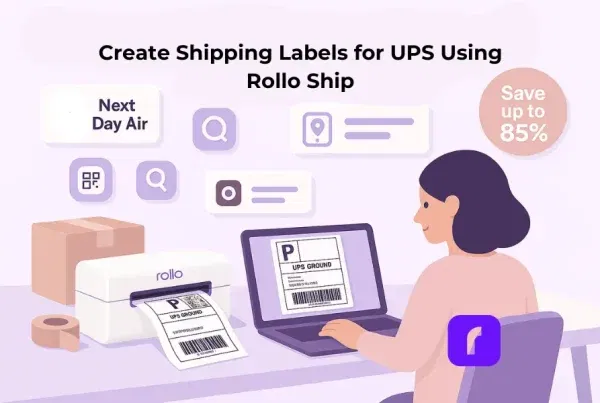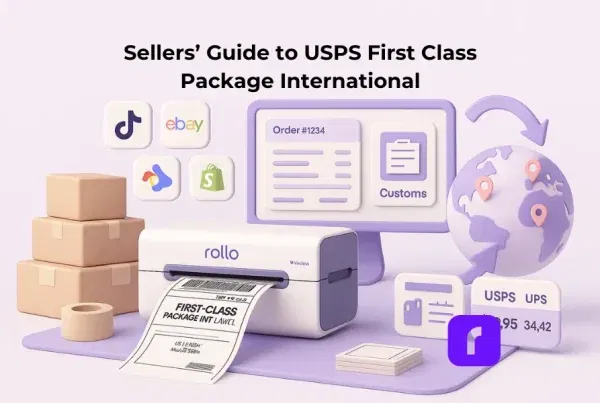Thermal printers have revolutionized the printing landscape with their efficiency, economy, and speed. They are particularly popular in the eCommerce industry for printing shipping labels, but their uses extend to various sectors, such as retail, healthcare, and logistics. In this article, we will explore the inner workings of a thermal printer, compare direct thermal and thermal transfer printing, and discuss the unique features of the Rollo Thermal Printer, which offers both wireless and USB connectivity and is AirPrint enabled for seamless printing.
Table of Contents:
- What Is A Thermal Printer?
- How Does Thermal Transfer Printing Work?
- The Benefits of Thermal Printers
- Disadvantages Of Thermal Printers
- What Is A Thermal Printer Used For?
- Difference Between Inkjet and Thermal Printers
- How to Choose the Best Thermal Label Printer for Your Needs
- FAQs
What Is A Thermal Printer?
How Does a Thermal Printer Work?
How Does Direct Thermal Printing Work?
How Does Thermal Transfer Printing Work?
The Benefits of Thermal Printers
These key points will help you understand the functionality of a thermal printer and what it has to offer you. Thermal printers provide a range of advantages such as fast printing, cost-effective operation, high-quality images, adaptability to diverse media types, and reduced waste production.
Disadvantages Of Thermal Printers
While thermal printers have numerous advantages, they also come with certain disadvantages, such as prints fading over time and restricted color printing options. Understanding both the pros and cons of thermal printers can help you determine if this type of printer is the right choice for you. Here is a list of the drawbacks associated with owning a thermal printer:

What Is A Thermal Printer Used For?
Thermal printers have a wide range of applications across various industries, including retail, kiosks, hospitals, gas stations, labs, and offices. Many businesses and organizations opt for thermal printers primarily for printing shipping or product labels, resulting in significant savings on ink costs and discounted shipping labels. Some common uses for thermal printers are: shipping labels, product labels, asset labels, visitor ID labels, receipt printing, and
library labels.
Who Could Benefit From A Thermal Printer?
Thermal printers, such as the Rollo thermal labels printer, are ideal for businesses and individuals who require efficient and economical printing solutions. Industries that can benefit from thermal printers include:
Difference Between Inkjet and Thermal Printers
Inkjet printers use ink that is sprayed onto the substrate in tiny droplets. While they have lower upfront costs compared to thermal printers, the maintenance and ink replacement costs are significantly higher. Thermal printers, such as the Rollo Thermal Printer, are more cost-effective in the long run due to their lower maintenance requirements and reduced ink or toner expenses. Additionally, thermal printers are generally more durable and portable, making them ideal for businesses that require frequent label printing.
Inkjet Printers
Thermal Printers
| Inkjet Printers | Thermal Printers | |
| Print Method | Nozzle-dispensed ink | Wax pigment or heated printhead |
| Costs | Lower upfront, higher ongoing | Higher upfront, lower ongoing |
| Print Quality | Can deteriorate over time | Limited colors, longer-lasting |
| Durability | More prone to issues | Low-maintenance, long-lasting printheads |
| Portability | Not portable | Compact and portable |
| Power | AC power | Battery-operated or AC power |
| Use Cases | Documents, photos, flyers, etc. | Labels, barcodes, receipts |

How to Choose the Best Thermal Label Printer for Your Needs
When selecting a thermal printer, consider the following factors:
Shopping Thermal Printers
The Rollo Thermal Printer: An Efficient and Eco-Friendly Solution
If you are looking for a reliable, efficient, and eco-friendly printing solution, the Rollo 4×6 thermal label printer is an excellent choice. With its wireless, USB, and AirPrint-enabled capabilities, it offers a versatile and user-friendly experience for businesses and individuals who need to print shipping labels, barcodes, or other labels quickly and economically. By choosing Rollo Thermal Printers and their FSC-certified labels, you are not only optimizing your printing process but also supporting sustainable practices.
💜 Rollo USB Thermal Printer
The Rollo USB printer connects to Mac or Windows computers using a USB cord. It features label detection, allowing the use of various label types, which the printer will automatically recognize. Capable of printing one label per second, this cheap thermal printer is easily transportable.
💜 Rollo Wireless Thermal Printer
The key difference between the Rollo USB and Rollo Wireless printer is the wireless connectivity, allowing users to send labels to the printer via Wi-Fi from any device. This AirPrint Certified printer doesn’t require driver installation and is compatible with Mac, iPhone, iPad, Android, Windows, Chromebook, and Linux. Like its USB counterpart, it can produce one label per second. Customers appreciate its portability and the convenience of printing without needing to plug in. Additionally, this printer updates itself automatically without requiring downloads or connection to a computer.
| Rollo USB Thermal Printer | Rollo Wireless Thermal Printer | |
| Connectivity | USB | Wi-Fi |
| Label Detection | Yes | Yes |
| Print Speed | 1 label/second | 1 label/second |
| Compatibility | Mac, Windows | Mac, iPhone, iPad, Android, Windows, Chromebook, Linux |
| Portability | Compact and transportable | Compact and transportable |
| AirPrint Certified | No | Yes |
| Automatic Updates | No | Yes |
FSC-Certified for Eco-Friendliness
Rollo is committed to sustainability and offers FSC-certified thermal labels, ensuring that the paper used in their labels comes from responsibly managed forests. By choosing Rollo Thermal Printers and their eco-friendly labels, you are not only optimizing your printing process but also supporting sustainable practices.
Are Thermal Printers Worth It?
If you require a convenient solution for shipping or product labeling, a thermal printer is the ideal choice. Although thermal printers may not have the same capabilities as inkjets, their maintenance costs are significantly lower than traditional printers. Despite the initial higher investment in purchasing a thermal printer, the long-term benefits make it a worthwhile option.
Summing it up
In conclusion, a thermal printer is a versatile, efficient, and cost-effective solution for various printing needs, particularly for shipping labels, barcodes, and product labels. The Rollo Thermal Printer stands out as an exceptional choice, offering wireless, USB, and AirPrint-enabled capabilities, as well as compatibility with FSC-certified labels for eco-friendliness. By investing in a Rollo Thermal Printer, you can streamline your printing process, save on ink and maintenance costs, and contribute to sustainable practices. Embrace the benefits of thermal printing technology and enhance your business operations today.
FAQs
”Q: 📷 Are thermal printers suitable for printing photos?
Short Answer: 🗙 No, due to limited color capabilities.A: Thermal printers are not ideal for printing photos, as they typically print only in one color and have limited color capabilities. They are better suited for label and receipt printing.
”Q: ⌚ When is a thermal printer used?
Short Answer: shipping labels, receipts, barcodes, and product labels in various industriesA: A thermal printer is used for various printing tasks such as shipping labels, receipts, barcodes, product labels, ID badges, and more. They are commonly used in retail stores, kiosks, hospitals, gas stations, labs, and business offices.
”Q: ☔ Are thermal printer labels waterproof?
Short answer: 💧 water-resistant but not fully waterproofA: Thermal printer labels are generally water-resistant but not completely waterproof. The durability of the labels depends on the type of material used, with some materials offering better water resistance than others.
”Q: 💻 What thermal printer is compatible with Chromebook?
Short Answer: Rollo Wireless Thermal Printer X1040A: The Rollo Wireless Thermal Printer is compatible with Chromebook, as it supports Wi-Fi connectivity and doesn't require any additional drivers to be installed. This makes it easy to print from a Chromebook or other compatible devices.
”Q: 🖨️ How Do Thermal Label Printers Work?
A: Thermal label printers, a specific type of thermal printer, operate using a heated printhead that activates either chemically treated specialty thermal paper or transfers solid black ink from a ribbon onto the material being printed. The key difference between thermal label printers and other thermal printers lies in their specialized use for label printing, making them essential tools for businesses needing efficient labeling solutions.
”Q: ❓ What Are Thermal Printers Used For?
A: Thermal printers are versatile tools with a multitude of applications, making them indispensable in various sectors. These printers are commonly used for tasks such as: printing shipping labels, generating product labels, creating asset labels, producing receipts, issuing ID badges, and streamlining library operations.




